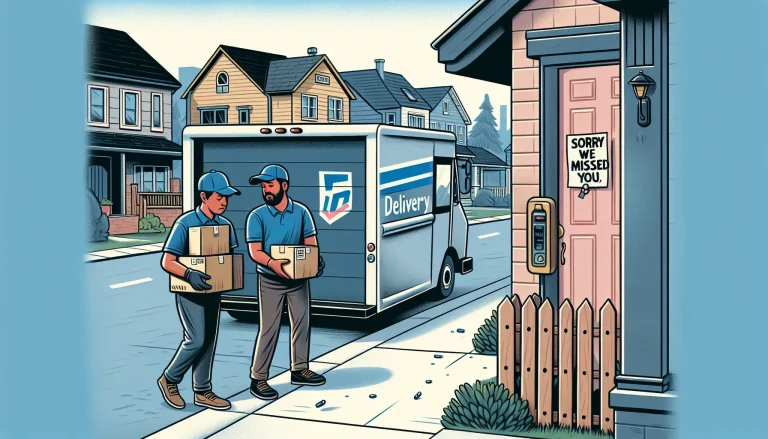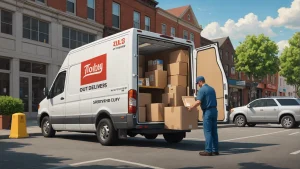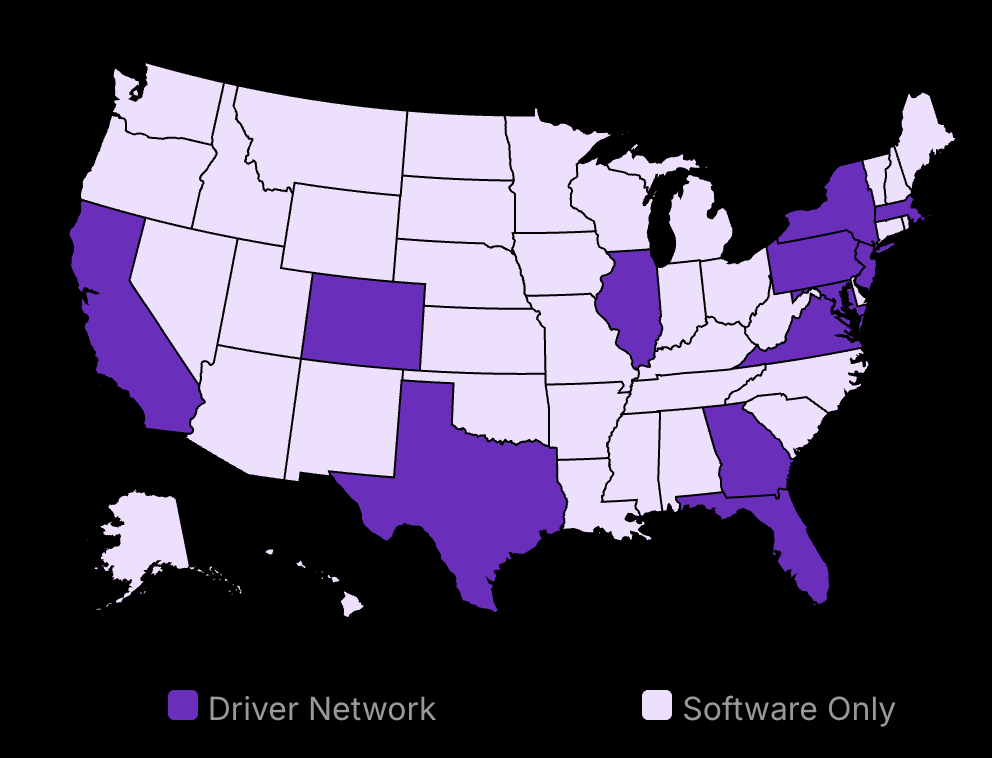Unsuccessful delivery attempts: they’re like weeds stunting the growth of your flourishing business before you even realize they’ve taken root. But what does a failed delivery attempt mean for business owners like you?
Think lost customers, sunk costs, and worst of all, tarnished reputation. And just like weeds, they’re better nipped in the bud.
Welcome to the “how-to guide” for understanding, anticipating, and avoiding these troublesome setbacks. Let’s reclaim the terrain for your flourishing business. No green thumb is necessary, just a sharp eye for logistics and customer satisfaction.

Earn $1,200+/week delivering for local businesses
Driver benefits:
- Steady local business routes
- Weekly pay + tips
- Dedicated support team
- Flexible scheduling
Understanding the Impact of Failed Delivery Attempts on Your Business
The Direct Consequences of Failed Deliveries
Failed deliveries directly hit the nerve of customer satisfaction. When customers place an order, they inescapably create a mental expectation of receiving it in the stipulated time frame. If this doesn’t happen, they feel disappointed, leading to immediate dissatisfaction.
Failed delivery attempt at the first delivery not only potentially loses the sale you just made, but can also discourage the customer from making future purchases – a serious blow to customer retention. Besides, dealing with missed deliveries can lead to added costs and operational inefficiency for your business. Curious about what “dispatched from sorting center” indicates for your shipments and how it impacts delivery times? Learn how this stage in the shipping process can affect customer satisfaction and your business operations.
The Long-Term Implications of Repeated Failed Deliveries
On a chronic scale, repeated failed deliveries tarnish your business’s reputation. Today’s consumers share their experiences online, good and bad, with one startling poor delivery experience capable of deterring potential customers.
Trust, once lost, can be significantly hard to regain. By being repeatedly unable to deliver orders accurately and on time, your business risks losing credibility in the eyes of your customer base, further damaging your brand image in the long run.
Remember, in the realm of online shopping, delivery success plays a crucial role in maintaining a satisfied customer base. Balancing immediacy and accuracy is key in ensuring this facet of your business runs smoothly. If not, the consequences – both immediate and long-term – can be detrimental to your business. Delve deeper into what it means when your package is ‘On the Way for Delivery’ and how it impacts the overall customer satisfaction and the success of your business.
Unpacking the Reasons for Failed Delivery Attempts
Common Causes of a Failed Delivery Attempt
1 in 4 delivery attempts fails due to common causes, impacting the customer experience and causing a significant effect on your bottom line.
The most frequent factor at play? Incorrect address details. Mix, incorrect, or incomplete address make-ups are not uncommon — spelling mistakes, transposed numbers, incomplete or wrong address and zip codes, and even complete address omissions happen more often than you might think. There’s also the case of nondescript addresses, where specific building details are not provided, throwing a wrench in the delivery process.
A second common culprit is recipient unavailability. Not all clients can be home to receive their parcels, especially during working hours. This can lead to failed or multiple delivery attempts sometimes, particularly when the attempted delivery requires signature confirmation.
The Impact of Returning Client Packages
When a delivery falls through, there’s more than just a simple reschedule. Returning client packages is an extra cost your business must bear and it’s one that can quickly add up. Balancing the cost of returns with reshaping your delivery strategy is a challenge all businesses must acknowledge.
Unique Challenges in Your Delivery Process
Every business has unique elements in its delivery process that can influence failure rates. Maybe you operate in a niche market with special delivery conditions, or perhaps your clientele is scattered, operating in hard-to-reach, remote areas.
The Complexity of Niche Market Deliveries
If you’re selling perishable goods or fragile items, for instance, the complexities multiply. Think temperamental weather conditions, short delivery windows, and logistical challenges – the sort of issues that demand a deft hand in planning and execution.
Remote Deliveries and the Last Mile Problem
The so-called ‘last mile’ issue often proves particularly challenging for businesses delivering in remote regions. With increased distances, complex routes, challenging terrains, and more unpredictability, it’s no surprise the final leg of the journey is often the hardest.
With these insights into the root causes of failed delivery attempts, your business is now in a prime position to start tackling these issues head-on. You are now equipped with the knowledge necessary to address these pain points one by one effectively.
Implementing Strategies to Avoid Failed Deliveries
Proactive Communication with Customers
Remember the old saying, “Forewarned is forearmed”. Customers appreciate being kept in the loop about the whereabouts of their deliveries. With effective and proactive communication strategies, like using an SMS gateway API, businesses can avoid unnecessary failed delivery attempts and ensure a satisfactory customer experience.
Look at it this way. Your customer needs to reschedule their day around the expected delivery. By providing regular updates and accurate, delivery details and timings, you save them from unnecessary waiting and frustration. Moreover, this gives you the chance to address any potential delivery problems in advance, too.
The secret, though, lies in the implementation. Using various channels like email, SMS, push notifications, or even phone calls could help keep the customer apprised of the delivery status and changes.
Leveraging Technology for Efficient Delivery Management
Automation isn’t just a buzzword; it’s an efficient way forward. Today’s technological advancements can significantly reduce the likelihood of failed deliveries.
The Alchemy of AI in Delivery Management
Imagine a system that not only tracks deliveries but also predicts potential bottlenecks and addresses them in real time. Modern AI-enabled routing software can handle complex calculations involving distance, vehicle capacity, delivery time, and much more in a fraction of a second. Businesses can fully tap into the potential of this technology for more efficient delivery operations.
The Benefits of Real-Time Delivery Tracking
Real-time delivery tracking technologies enable courier businesses to know precisely where their deliveries are in real-time. This reduces failed attempts by ensuring the timely presence of all parties involved during a second delivery attempt. Plus, it provides actionable insights into inefficiencies in the delivery process, paving the way for improvements.
The Impact of Robotic Process Automation (RPA)
Robotic Process Automation, or RPA, can automate mundane tasks like address verification, scheduling, and tracking, effectively reducing the time spent on manual processes and thus, helping prevent missed delivery attempts.
Leveraging these technologies can not only help in smoothly managing deliveries but also in avoiding the damages of potential failures.
Navigating the maze of several failed delivery attempts can be complex, but taking the time to nail down effective communication strategies and employing technology can make it easier.
The Role of Customer Experience in Failed Deliveries
How Failed Deliveries Affect Customer Experience
Failed deliveries can have a profound negative impact on the customer experience. When a customer does not receive their product or service as promised, it can lead to immediate dissatisfaction and even long-term loss of trust. Understand the significance of a delivery time frame and its role in avoiding missed parcels and ensuring customer satisfaction.
The anticipation of a delivery is often filled with excitement, especially if it’s a result of careful selection or a much-needed item. A missed or late delivery can instantly transform this positive sentiment into frustration. It might be more than a simple delay; it can be seen as a promise which wasn’t kept. This sketchy reliability reinforces negative perceptions and potentially churns customers.
Enriching Customer Experience Post Failed Deliveries
While it might seem paradoxical, failed deliveries can, in fact, present valuable opportunities to significantly boost customer experience. A key step is acknowledging the mistake, extending a sincere apology, and ensuring swift resolution. Transparency in communication goes a long way in maintaining customer trust.
Moreover, businesses can leverage these situations to exceed customer expectations. For example, offering a discount on the next purchase or expedited, free reshipment displays proactivity and commitment to customer satisfaction.
Turning Failed Deliveries into Positive Customer Interactions
Whilst no business endeavors to fail in its delivery promises, mistakes do occur. The critical reflection point should not necessarily be the disappointment, however how companies manage the situation and innovate solutions that transform the customer sentiment.
Open, honest communication is key to turning a failed delivery attempt scenario around. When a mistake has been made, businesses should proactively reach out to the customer, explaining the situation and presenting a remedy. This is often appreciated and results in increased loyalty. Delve into the importance of the ‘Out for Delivery’ notification and what it means for the smooth transition of goods to your doorstep, ensuring a positive customer experience.
Weaving empathy into customer interactions can also make a lasting impact. A speedy resolution is good, but a personalized, sincere note accompanying the resolution can touch customers on a more emotional level, potentially strengthening the bond.
So, while it’s pivotal to adopt strategies to minimize delivery failures, it’s equally crucial to devise a contingency plan that consistently places the customer’s experience at the helm. These strategies can serve as a lifeline during challenging times, ensuring superior service at all times.
Understanding the Cost Implications of Failed Deliveries
The Direct Costs of Failed Deliveries
Failed deliveries add needless weight to your business expenses. They not only involve cost investment in the form of lost employee time and wasted fuel but also additional re-deliveries. These repeated attempts can double or even triple the expense you initially outlined for your delivery operation. The number of extra kilometers traveled per first delivery attempt also pushes up the maintenance costs, shortening the lifespan of your delivery vehicles and adding an unanticipated price to your ongoing operations.
But there’s more to this issue than higher direct costs. It’s a matter of sustainability too. More journeys mean more carbon emissions, making your business a bigger part of the global pollution problem. It’s a negative mark against your corporate social responsibility efforts, a fact that’s especially damaging in an era where consumers increasingly prioritize environmentally conscious brands.
Also, there are tangible repercussions relating to your brand’s image, credibility, and the quality of your customer service – elements that form the crux of the following section.
The Indirect Costs of Failed Deliveries
Failed deliveries don’t merely force your business to bear the brunt of additional financial costs. They can also lead to more subtle, yet possibly more damaging, long-term costs associated with your brand reputation and customer loyalty.
Your customers expect their items to be delivered at a specified time. A failed delivery attempt disrupts their schedule and possibly their plans, leading to frustration and dissatisfaction. This negative experience sours their perception of your brand, making them less likely to return for repeat business. After all, why would they place their trust in a brand that couldn’t deliver on its promises, quite literally, the first time?
A damaged reputation can also deter potential customers. Online reviews and word-of-mouth hold significant sway in today’s digital world. One customer sharing their disappointment over a failed delivery attempt can put off countless prospects, eroding your customer base over time. Worse, rebuilding a tarnished brand image requires an enormous amount of effort, time, and resources.
Facing Down Failed Deliveries
An unsuccessful delivery attempt can be detrimental to businesses of any size, costing precious time and resources. Better communication, thorough address verification, and flexible delivery options can mitigate these delivery attempt fails, sparing both financial losses and a hit to your reputation.
Remember, your customers aren’t just buying a product; they’re also buying a successful delivery experience. When a package doesn’t arrive as expected, it creates friction in that user experience. With proper strategies in place, you can ensure smoother, more successful deliveries and a heightened customer experience. Knowing the Estimated Arrival Time of your packages can play a significant role in enhancing the overall customer satisfaction with their delivery experience.
Given these circumstances, why not take a second look at your current delivery practices? Consider investing in systems that ensure delivery preferences are precise addressing successful first delivery attempts and strive for transparency in your communication. Offer your customers flexible delivery options where possible.
Thinking about your last package delivery mishap – how might better communication or correct address verification have made a difference?
And remember, every successful first delivery attempt is a step towards earning another satisfied customer and an advocate for your brand. Make every delivery count!





























